15 red birds of Florida (With Pictures)
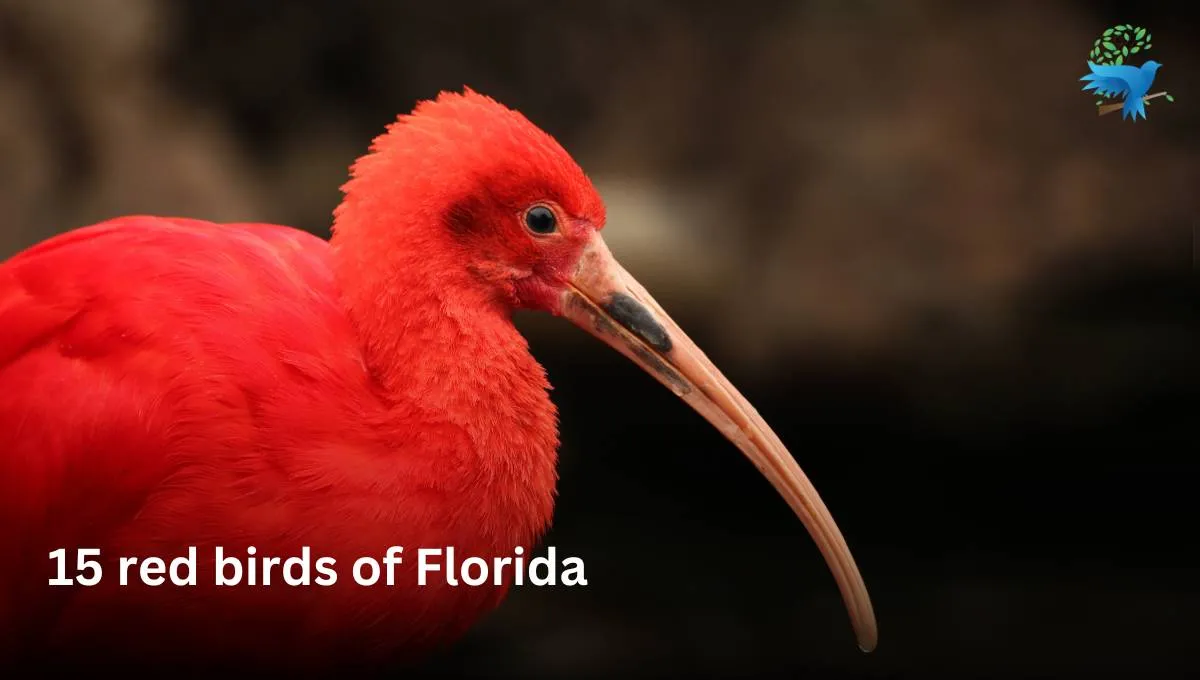
Florida is one of the states in the Southeastern region of the United States of America. It is world-renowned for its amusement parks, beach resorts, and warm and sunny climate.
Florida is also home to over 550 bird species. Furthermore, different types of red birds call Florida home.
If you are a bird lover, you might be happy to know that these articles will cover Florida’s top 15 red birds. So stick till the end.
List of 15 Red Birds of Florida
The list of 15 red birds in Florida are as follows:
- Northern cardinal
- Scarlet Ibis
- Red-Headed Woodpecker
- Scarlet Tanager
- Rose-breasted Grosbeak
- Common Redpoll
- Roseate Spoonbill
- Red-winged Blackbird
- Summer Tanager (Male)
- Red-bellied Woodpecker
- Vermilion Flycatcher
- House Finch
- Painted Bunting
- Red-masked parakeets
- Purple Finch
1. Northern cardinal
The northern cardinal, also known as a red bird, is a year-round resident of Florida and the most common songbird in the state.
It is a relatively large, long-tailed bird with a short, thick bill and a prominent crest. They often sit arch-over, with their tails pointed straight down.

Both male and female cardinals have bright orange beaks. Male cardinals are bright red except for a large, black mask on their faces.
The average lifespan of northern cardinals is at least three years. Yet there have been reports of Northern cardinals growing as old as fifteen years.
Size and wingspan of Northern cardinal:
- Length: 21–23.5 cm (8.3–9.3 in)
- Wingspan: 25–31 cm (9.8–12.2 in)
- Weight: 33.6–65 g (1.19–2.29 oz)
The male Northern cardinal weighs slightly more than the female.
Northern cardinals are found throughout Florida. They live on forest edges, thickets, marshes, and mangrove forests in coastal intertidal zones.
These birds can also be found in southeastern Canada and the eastern and central United States, southern Arizona and New Mexico, much of Mexico, and northern Belize and Guatemala.
Northern cardinals prey on insects, such as ants, beetles, centipedes, true bugs, caterpillars, grasshoppers, flies, snails, and spiders.
They also eat primarily vegetables, including weed and grass seeds, waste grain, leaf buds, flowers, and various berries and wild fruits.
2. Scarlet Ibis
The scientific name for the scarlet ibis, sometimes known as the red ibis, is Eudocimus ruber. It is brilliant red, with a dark beak and black-tipped feathers.
This wading bird has long pink legs, partially webbed toes, and a long, curved bill.
The scarlet ibis lives for roughly sixteen years in its natural environment and twenty years in captivity.
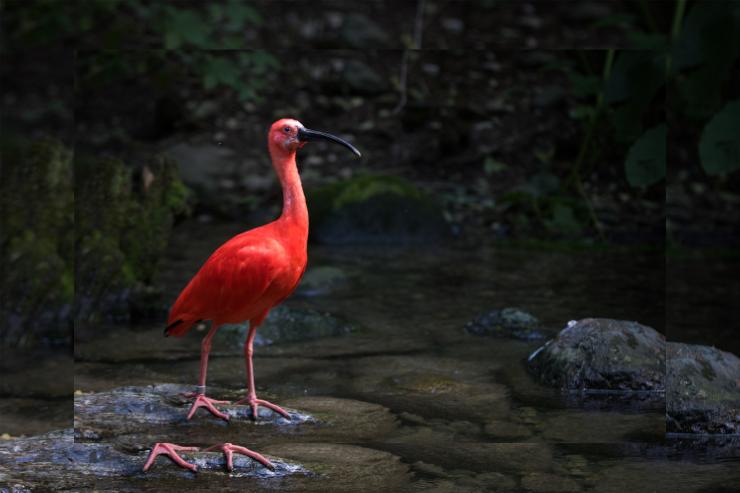
Size and wingspan of Scarlet Ibis:
- Length: 55–63 centimeters (22–25 inches)
- Wingspan: 54 centimeters (21 inches)
- Weight: 1.4 kilograms (3.1 lb)
Scarlet ibises can be found in a range of shallow-water environments, including mudflats, coastal areas, wetlands, and tropical rainforests.
These Scarlet ibis are native to South America but can sometimes be seen in Central America, the Caribbean, and southern Florida. You can see Scarlet Ibis occasionally in Florida.
Scarlet ibises eat many foods, including crabs and other crustaceans, tiny fish, frogs, mollusks, insects, and worms.
3. Red-Headed Woodpecker
Red-headed woodpeckers are sexually monomorphic, which means that males and females look identical.
Adults have bright red heads, white underparts, and black backs with prominent patches on the wings, making the lower back look completely white when perched.
Immatures have gray-brown heads, and the white wing patches reveal rows of black dots along the trailing edge.
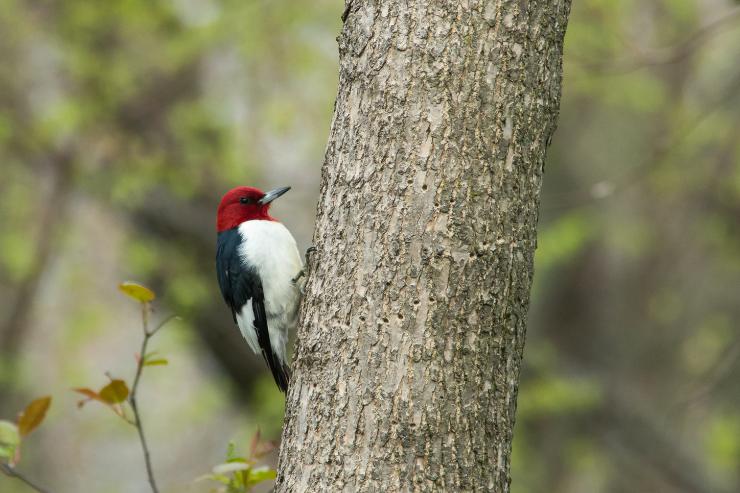
The average wildlife span is 119 months. However, as the oldest known red-headed woodpecker lived for at least nine years and 11 months, the maximum lifetime in their range is predicted to be 12 years.
Size and wingspan of Red-Headed Woodpecker:
- Length: 19 to 25 centimeters(7.5 to 9.8 inches)
- Wingspan: 42.5 centimeters (16.7 inches)
- Weight: 56 to 97 grams (2.0 to 3.4 oz)
Red-headed Woodpeckers are found across the central and eastern United States and southern Canada. They live in forest peripheries, orchards, open pine woods, and tall tree woodlands.
These birds live all year in Florida’s pine woods, which have open forest floors, orchards, and towering trees in neighbourhoods.
The red-headed woodpecker is an omnivore. It consumes insects, spiders, earthworms, seeds, nuts, fruits, berries, and, on occasion, small mammals.
It may also consume bird eggs, fledglings, and mice.
4. Scarlet Tanager
The scarlet tanager is a medium-sized, red American songbird. This little songbird is among the many migratory birds found in North America.
Adult scarlet tanager males are distinguishable in the spring and summer by their striking coloration of red and black wings and tails.
Females and fall immature are olive-yellow, with dark olive wings and tails. After breeding, adult males change into female plumage with black wings and tails.
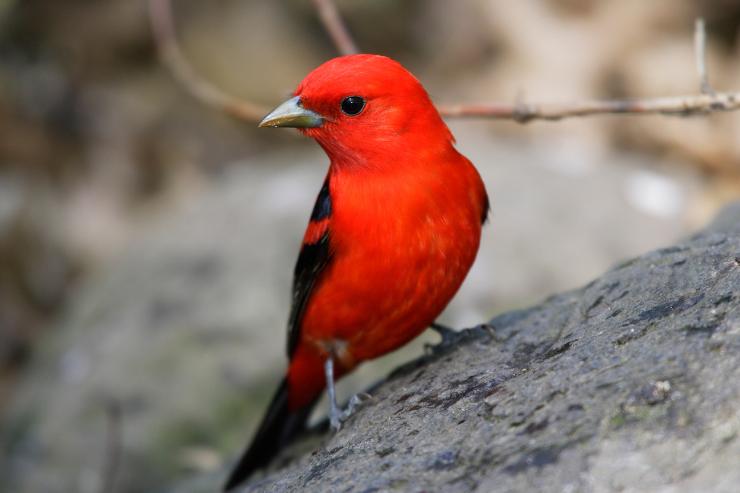
The Scarlet Tanager’s exact lifespan is unknown. However, the oldest known Scarlet Tanager was a male aged 11 years and 11 months.
Size and wingspan of Scarlet Tanager:
- Length: 6 to 19 centimeters (6.3 to 7.5 inches)
- Wingspan: 25 to 30 centimeters (9.8 to 11.8 inches)
- Weight: 23.5 to 38 grams (0.83 to 1.34 oz)
Scarlet Tanagers live in forests and shade trees, particularly oaks.
These species are typically found in deciduous forests, mainly where oaks are common, but sometimes in beech, maple, and other trees; sometimes in mixed pine-oak woodlands; and sometimes in coniferous woods filled with pine or hemlock.
The Scarlet Tanager, a native of the Northeast United States, travels through Florida on its way to and from South America.
During the summer, the Scarlet Tanager eats mostly insects, especially wasps, caterpillars, beetles, moths, bees, spiders, millipedes, snails, worms, and aphids.
It also eats wild fruits and berries like sumac and mulberries.
During the winter, the Scarlet Tanager, like many other migratory birds between North America and the tropics, feeds on fruits and insects, which remain its primary food source in the warmer months.
5. Rose-breasted Grosbeak
Rose-breasted Grosbeaks have large, heavy bills of pale pinkish white. Adult male Rose-breasted Grosbeaks upper parts are black, with white wing patches and a rump.
The underparts are white, with a black throat and rosy-red breasts. Males have dark wings with white spots and rosy red wing linings in flight.
In winter, a male Grosbeak’s feathers have brown and white dots with a pink tinge.
The female is brown above with a large white crest and wing bars and extensively striped below with a yellow wing lining that can be seen in flight.
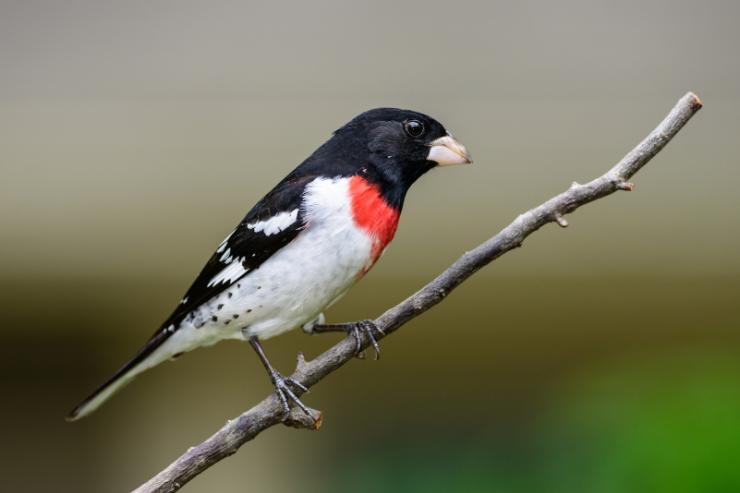
In the wild, rose-breasted grosbeaks have an average maximum lifespan of 7.3 years, whereas in confinement, they can live up to 24 years.
Size and wingspan of Rose-breasted grosbeaks:
- Length: 18–22 centimeters (7.1–8.7 inches)
- Wingspan: 29–33 centimeters (11–13 inches)
- Weight: 35–65 grams (1.2–2.3 oz)
Rose-breasted grosbeaks are most commonly seen in open deciduous woods but also in mixed woodlands.
They prefer edges or openings with shrubs and massive trees over the entire forest. In migration, they can occur in any wooded or semi-open environment.
Their habitats cover the northeastern United States and extend into southeastern and central Canada.
These species eat beetles, bees, ants, caterpillars, berries, and weed seeds such as sunflowers, foxtail, and milkweed.
They have also been found to consume domestic crops such as oats, corn, wheat, and peas.
6. Common Redpoll
The small Common Redpoll is one of the smallest members of the finch family.
This bird weighs as little as four pennies but survives the cold and darkness of winter in the Far North.
It has a short, conical yellow bill, a dark area beneath it, a red spot on its forehead, dark wings, and dark streaks on its flanks and upper body.
An adult Common Redpoll male has a reddish wash across his breast. These species live for two to three years.
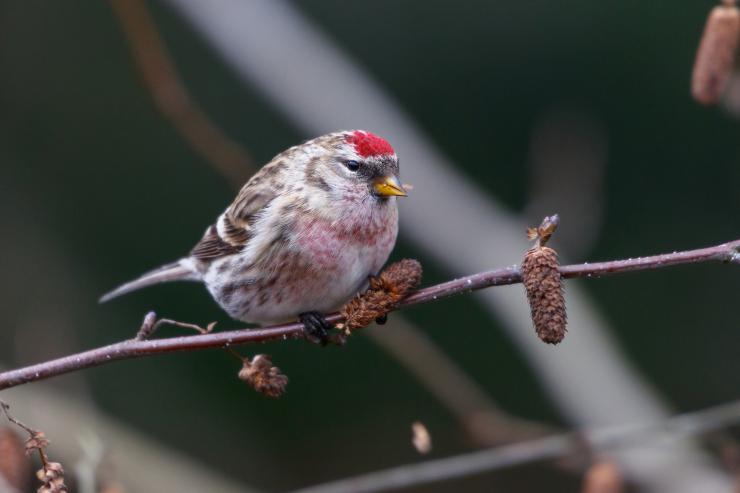
Size and wingspan of Common Redpoll:
- Length: 12 to 14 centimeters (4.7 to 5.5 inches )
- Wingspan: 19 to 22 centimeters (7.5 to 8.7 inches)
- Weight: 11 to 20 grams (0.4 to 0.7 ounces)
The Common Redpolls breed is a worldwide bird in the far northern latitudes, in open woodlands of pine, spruce, alder, birch, and willow up to 5,000 feet elevation.
This bird can also be found on treeless tundra, where it seeks out hollows and shelters where deciduous or coniferous plants can grow.
They also live near towns. This species feeds mainly on seeds and other vegetative litter throughout the year.
It also consumes the seeds and buds of willows, birches, alders, microscopic conifer seeds, and numerous weed and grass seeds. It also eats insects, especially in the summer.
7. Roseate Spoonbill
The Roseate Spoonbill belongs to the family “Threskiornithidae.” It has bright pink feathers and underparts (with red on the tips of the wings), a white neck and back, red eyes, a spoon-shaped beak, and pinkish legs and feet.
While the species appears almost pink in flight, they have no feathers on their heads. They can live for up to ten years.
However, the oldest known Roseate Spoonbill was at least fifteen years and ten months old when it was discovered and rereleased during scientific research in Florida in 2006.
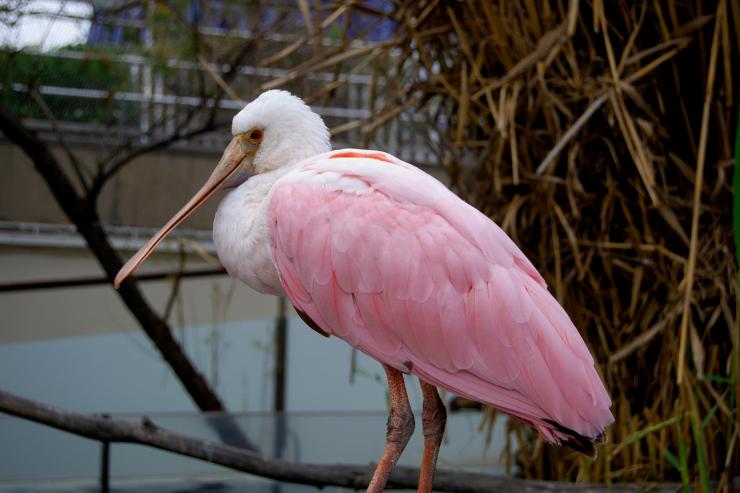
In the United States, in Florida, these species of Roseate Spoonbill are found in Florida Bay, Brevard County, and Tampa Bay.
Size and wingspan of Roseate Spoonbill:
- Size: 80 centimeters (31.5 inches)
- Wingspan: 1.3 meters (4.3 feet)
- Weight: 1.6 kilograms (3.5 Ib)
The Roseate Spoonbill is one of the world’s six spoonbill species and the only one found in the Americas.
It lives throughout South America, primarily east of the Andes, as well as along the coasts of Central America, the Caribbean, and the Gulf of Mexico.
Roseate spoonbills eat minnows, tiny crustaceans, insects, and plant fragments. It uses its spoon-like bill to grab prey out of shallow water.
They eat in freshwater and saltwater marshes in the early morning and late evening.
8. Red-winged Blackbird
Red-winged Blackbirds are shiny black with red and yellow shoulders. Female Red-winged Blackbirds have significantly diverse looks.
Females are striped and dark brownish, whiter on the breast, and frequently have a whitish eyebrow.
The red-winged blackbird gets its common name from the primarily black adult male’s prominent red shoulder patches, visible when the bird flies.
In the winter, Red-winged Blackbirds assemble in large flocks to eat grains alongside other blackbird species. These birds are easily differentiated by their singing and bright red patterns on their wings.
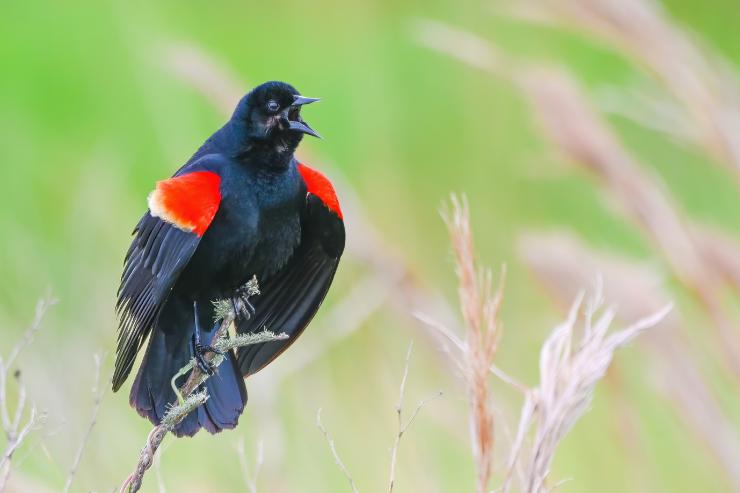
In the wild, it has an average life span of 2.14 years. Moreover, the oldest reported red-winged blackbird in the wild lived 15 years and nine months.
Size and wingspan of Red-winged Blackbird:
- Length: 22- 24 centimeters (8.7 – 9.4 inches)
- Wingspan: 31 and 40 centimeters (12 – 16 inches)
- Weight: 65 – 80 grams(2.1 to 2.7 ounces)
Red-winged Blackbirds can be found in salt and freshwater marshes, along watercourses, water hazards on golf courses, moist roadside areas, drier meadows, and ancient fields.
These birds can be found in grain fields, farms, and meadows in winter.
They consume various insects, particularly in the summer, including beetles, millipedes, caterpillars, spiders, grasshoppers, and snails.
These species’ diets also consist of seeds, including grass, weeds, and waste grain. They also consume berries and tiny fruits.
9. Summer Tanager (Male)
The Summer Tanager is a beautiful bird with red all over the male body. Females, on the other hand, have an entirely different color.
However, molting young males can be spotty, yellow, and red. The scientific name for the Summer Tanager is Piranga rubra, an American songbird.
It has a minimum lifespan of seven years.
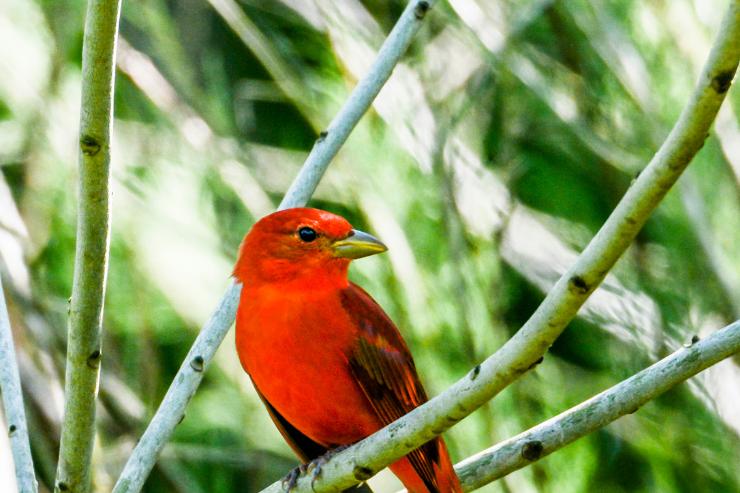
Size and wingspan of Summer Tanager:
- Length: 17 centimeters (6.7 inches)
- Wingspan: 28 to 30 centimeters (11.02-11.81 inches)
- Weight: 29 grams (1.0 oz)
This species lives in the southern United States and northern Mexico during the summer.
In the winter, Summer Tanagers travel to southern Mexico, Central America, and northern and western South America.
They can be witnessed throughout the year in Florida, although these birds are most visible during the spring and fall migrations.
In the summer, Summer Tanager prefers open and riparian woodlands and forests. They can also be found in orchards, beachside areas, yards and parks.
Consequently, in the winter, the Summer Tanager bird visit forest margins, open woodlands, gardens, yards, and forests.
Summer Tanager’s diet consists mainly of insects such as bees and wasps, yet it also consumes many beetles, caterpillars, grasshoppers, bugs, and flies.
It occasionally consumes berries and small fruits.
10. Red-bellied Woodpecker
The red-bellied Woodpecker usually looks pale overall, especially with its vividly black-and-white striped back and blazing red crown and neck.
This bird has white spots near its wingtips while it flies. Red-bellied woodpeckers are noisy birds with a variety of sounds.
Calls are defined as sounding like churr-churr-churr or thrraa-thrraa-thrraa, with an alternating br-r-r-r-t sound.
The oldest known red-bellied Woodpecker was a male in Georgia who was at least 12 years old and three months old when it was discovered in the wild.
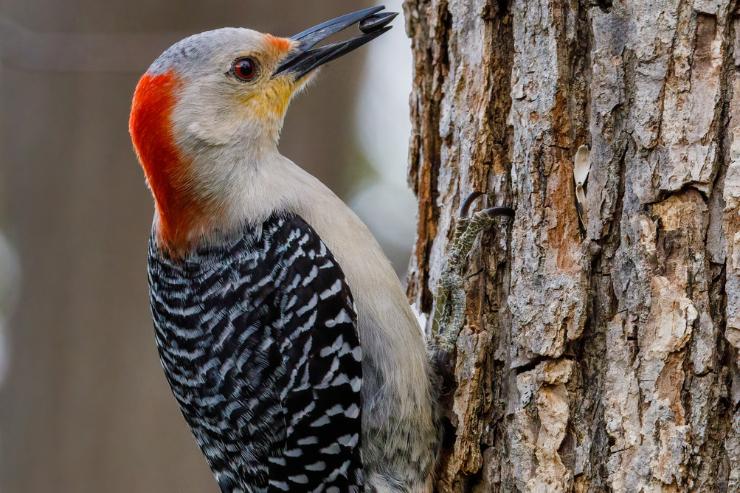
Size and wingspan of Red-bellied Woodpecker:
- Length: 22.85 to 26.7 centimeters (9.00 to 10.51 inches)
- Wingspan: 38 to 46 centimeters (15 to 18 inches)
- Weight: 56–91 grams(2.0–3.2 oz)
The Red-bellied Woodpecker is most frequent in deciduous forests, mainly near rivers and wetlands.
They are found in mixed coniferous and deciduous forests, though less commonly in pure pine stands.
Red-bellied Woodpeckers are omnivorous, and they eat a variety of insects, as do most woodpeckers.
During certain seasons, their diet may consist of more than 50 percent plant material, such as acorns and other nuts, wild and cultivated fruits, and seeds.
These species occasionally eat tree frogs, small bird eggs, leaking sap, and small fish.
11. Vermilion Flycatcher
Vermilion Flycatchers are a little yet colorful bird.
Male Vermilion Flycatchers are bright orange-red with a dark brown mask over their eyes and a brown back, tail, and wings.
Likewise, females and immatures are grey-brown with slight lines on the breast and a salmon-colored blush on the underparts.
These birds have a life expectancy of four years and six months. Although Vermilion flycatchers are widespread throughout the country, they are a species of minimal concern.
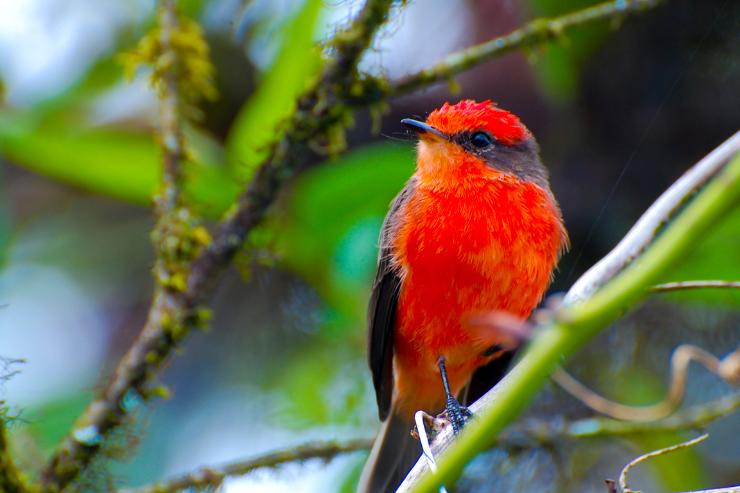
Size and wingspan of Vermilion Flycatcher:
- Length: 13–14 centimeters (5.1–5.5 inches)
- Wingspan: 24 to 25 centimeters (9.4 to 9.8 inches)
- Weight: 11 and 14 grams (0.39 and 0.49 oz)
The Vermilion Flycatcher can be found throughout the American Southwest in open country, including arid scrublands, deserts, farmlands, canyon mouths, and parks.
Vermilion Flycatchers eat mainly flying insects.
They catch insects on the wing by flying out from an exposed perch, such as grasshoppers or butterflies, and whacking them against the perch to control and soften them before eating.
They also eat honeybees, crickets, and beetles.
12. House Finch
House finches are adaptable, colorful, and cheerful-voiced birds. They have a conical seed-eating beak and a notched tail, like those of other finches.
Adult male house finches are rosy-red around the forehead and upper breast, with streaky brown back, abdomen, and tail.
House Finches can live more than 11 years in the wild and are naturally drawn to bird feeders.

Size and Wingspan of House Finches:
- Length: 12.5 to 15 centimeters (5 to 6 inches)
- Wingspan: 20 to 25 centimeters (8 to 10 inches)
- Weight: 21 grams (0.7 oz)
The House Finch’s range increased fast, most likely due to attempts to draw these birds to backyard bird feeders. House finches can be found in most of the United States.
House Finches are common birds in human-made environments such as buildings, lawns, tiny conifers, and urban areas. In rural places, House Finches can be found around barns and stables.
These species eat plant materials such as seeds, buds, and fruits. They also eat wild foods, such as knotweed, mustard seeds, poison oak, thistle, cactus, mulberry, and others.
House Finches also consume plums, blackberries, cherries, pears, peaches, strawberries, apricots, and figs in orchards.
13. Painted Bunting
Painted bunting Males have striking colors, with blue heads, red underparts, and greenbacks.
Females and immatures have a consistent bright yellow-green color with pale eyes. A painted bunting can live for at least twelve years.
The painted Bunting is one of the fastest disappearing songbirds in the eastern United States.
According to Florida breeding and winter season studies, the population of this species is decreasing by 4-6 per cent per year.
In some regions, counts have dropped from hundreds to a few.

Size and wingspan of Painted Bunting:
- Length: 12–14 centimeters (4.7–5.5 inches)
- Wingspan: 21–23 centimeters (8.3–9.1 inches)
- Weight: 13–19 grams (0.46–0.67 oz)
Florida is the only state where the colorful Eastern Painted Bunting breeds and spends the winter.
Buntings like to live in brushy vegetation in open locations such as roadside thickets and field boundaries.
They are also found in frequent backyard gardens in search of seeds. Painted Bunting feeds mainly grass and weed seeds but occasionally eats berries and fruits.
It also eats various insects, including beetles, caterpillars, grasshoppers, flies, and more.
These birds probably eat more insects in early summer and feed them to their young.
14. Red-masked Parakeet
Red-masked Parakeets are medium-sized parrots. They are commonly kept as pets and are also known in aviculture as the cherry or red-headed conure.
They are also regarded as the best talkers in all conures.
Red-masked parakeets have bright red on their crown, face, and throat, as well as on the leading edge of their wings and underwing coverts. They live for 25 years.
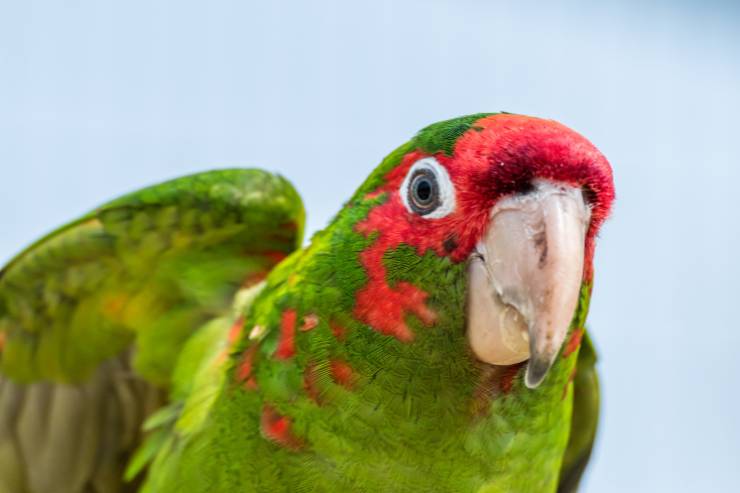
Size and weight of Red-masked parakeets:
Length: 33 centimeters (13 inches)
Weight: 165-200 grams (5.8-7 oz)
The Red-masked Parakeet was introduced to South Florida in 1986 and has subsequently increased in number and range.
Red-masked Parakeet can be found worldwide in warm climates, from India and Sri Lanka to Australia, the Pacific Islands, Southeast Asia, and tropical America.
They usually form big flocks and can be significant pests in crops.
Red-masked Parakeets eat the pulp but not the seeds. They also eat the fruits of Hyeronima alchorneoides, though they may eat the seeds once cracked.
Fruits and flowers are also included in the diet of the red-masked Parakeet.
15. Purple Finch
The purple finch belongs to the finch family Fringillidae. Male Purple Finches have beautiful pink-red heads, breasts, brown backs, and foggy white bellies.
Female Purple Finches have no red. They are roughly striped below, with distinct facial features such as a pale eyestripe and a dark line along the side of the throat.
Purple finch’s life span is typically three to five years.

Size and wingspan of Purple Finch:
- Length: 112–16 centimeters (4.7–6.3 inches)
- Wingspan: 22-26 centimeters (8.7-10.2 inches)
- Weight: 18–32 grams (0.63–1.13 oz)
Purple finches are found in Canada, the Pacific, and the Northeast. In the winter, they travel as far south as Florida.
They reside in the woods, groves, and suburbia. These breeds are primarily in coniferous and mixed woodlands within the forest and around the margins.
During migration and winter, they can be found in a wide range of wooded and semi-open environments, including forests, marshes, and suburbs.
Purple Finches dine primarily on seeds in the winter, including those of trees such as ash and elm and grass and weed seeds.
These species devour various tree buds, berries, and miniature fruits. In the summer, they eat various insects, mostly caterpillars and beetles.
Conclusion
Florida is known for a wide variety of lively bird species, making it a birder’s delight. Florida’s diversified bird population includes a wide variety of red-hued birds, each with its own set of features and habitats.
From the renowned Northern Cardinal to the Purple Finch, each of the 15 species has its own unique features.
These birds, which range from year-round residents to migratory visitors, can be found in various environments throughout Florida, including forests, marshes, parks, and yards.
Whether you’re exploring the forest or just gazing from your backyard, witnessing these beautiful redbirds adds a touch of beauty to Florida’s diverse birding experience.
So grab a pair of binoculars and engage in the fascinating world of Florida’s redbirds!






